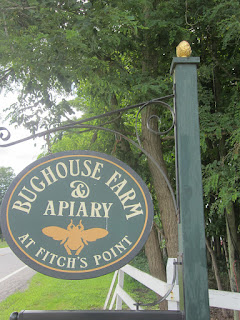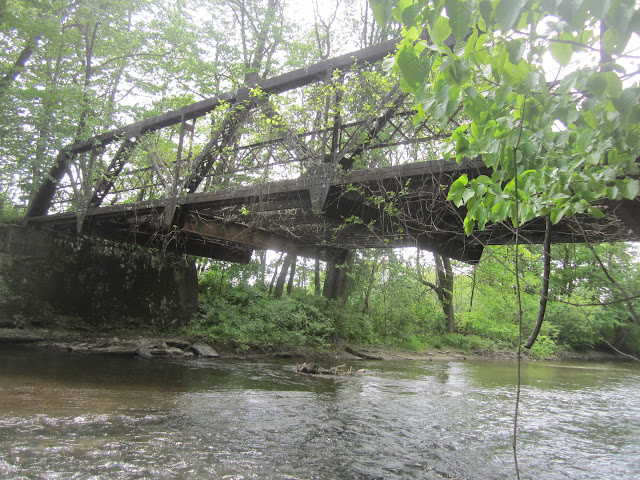Anyone else feeling bugged?
As in, literally tormented by bugs. Happens every year about this time. As summer's heat and humidity build to a crescendo, so does the population of noisome insects. In the kitchen ants march two by two across the counter while house flies rule the ceiling above. Their cousins the deer flies (from the bad side of the family) turn a walk in the woods into torment. If you survive till evening there's no reward because mosquitoes will pester you when you try to sit outside. What's almost as bad is the guilt I feel for detesting the little beasts. Shouldn't a good naturalist appreciate all of nature?
My solution has been to spend some time with a great naturalist who loved all things 'bug'. His name was Asa Fitch and he lived in the 1800's near Salem. In fact, the site of his home farm is still called Fitch Point to this day. Obviously, he's not still around in the flesh but with his writings, books written about him and wandering where he once did you can get a good sense of the man. Let's hang out with Mr. Fitch and see if we can't change some of our bad attitudes toward Class Insecta.
First, a brief introduction. The Fitch's were English Puritans who first came to America in 1638. Around 1780 a Fitch moved to Salem, then known as New Perth. Eventually the family bought a farm that came to total 600 acres and included a mill site on the Battenkill. This is just beyond present day East Greenwich, on a point of land formed by the confluence of Black Creek and the Battenkill. Traveling on Rt. 29 today, the Fitch house is located opposite the Cargill mill. Note that there is a relatively (for Washington County) large level area here. This was formed as the glacier melted 13,000 years ago and gravelly outwash poured into a temporary lake. It has been farmed continuously since European people first settled here.
The Asa Fitch that we'll get to know was born in the large old house (now just visible thru the trees) on February 24, 1809. Both he and his father were named Asa and both were medical doctors which can lead to some confusion. The second generation Asa lived most of his life at Fitch's Point passing away in the same house he was born in on April 8, 1879. He was educated, first at a local school at Fitch Point, then at Washington Academy in Salem and later at the Rensselaer School in Troy (later to become RPI), finally receiving his medical degree in Castleton, Vermont in 1829.
Fitch practiced medicine for a few years in Fort Miller and Stillwater before returning to the family farm in 1838 to take over from his aging father. He soon gave up his medical practice to devote his energies to farming but still made time for his true passion which was nature study. While he was knowledgable in many areas of Washington County natural history (including geology) it was insects that he was most passionate about and that became his eventually claim to fame.
Fitch became something of a joke to his neighbors who called him 'The Bug Catcher' as they watched him on hands and knees searching for specimens. His office was known as 'the bug house' and it was filled with mineral specimens, dried plants, preserved animals and cases of collected insects. The building still stands today off to the side of the large main house although I don't know what became of his collections.
Agriculture was New York's major industry and by the mid-1800's it was recognized that inspect pests were causing large economic losses. At the same time Fitch's expertise was recognized in Albany and he was called upon to research damage in fruits and grains. His reports were so well done and helpful that he continued for many years as the defacto state entomologist with a salary of $1000.
What's impressive is that, while establishing entomology as a science in New York State, Fitch also had time to contribute the geology section to Crisfield Johnson's 1878 History of Washington County, New York and to collect oral histories from elderly friends and neighbors that totaled into hundreds of pages of memories dating back to the earliest days of settlement. All this while running a large diversified farm. As the saying goes, "They don't make them like they used to."
You can visit Fitch's grave at Evergreen Cemetery just a few minutes from his home towards Salem. The monuments inscription reads:
Asa Fitch
Physician and Naturalist
Eminent among compatriots:
Fame had not the power to win
from him humbleness of spirit,
purity of soul, modesty of
demeanor, charity and love
for his fellow men.
And, I might add, love of nature. Even (especially) bugs.
MORE...















Don - Great post. Fitch had an earlier geologic survey of the County that was published in 1849: "A historical, topographical & agricultural survey of the county of Washington, taken under the direction of the New York State Agricultural Society", by Asa Fitch. You can check it out at Crandall Library's Folklife Center (always worth a visit). Here's a photo of his Washington County geologic cross-sections from the Folklife copy of that publication: https://www.flickr.com/photos/79475348@N03/52596596094/in/album-72177720305201032
ReplyDeleteInteresting. I've always wanted to check out some of the sites Fitch mentions in the 1878 Geology of W.C. article. On page 90 he describes Potsdam sandstone eroded by Winchell Creek northeast of Fort Ann: "...deep, narrow dells and defiles occur, bounded by perpendicular walls of this rock, sometimes branching and running into each other, and having a most singular and romantic aspect, causing the beholder to almost fancy himself among ruined castles and towers of the days of old." My type of place! Not sure of the exact location and it's probably on private property but if you ever find it be sure to send along some photos.
Delete